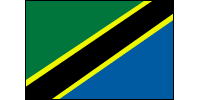| Country (long form) |
United Republic of Tanzania |
| Capital |
Dar es Salaam
note: some legislative offices have been transferred to Dodoma, which is planned as the new national capital; the National Assembly now meets there on regular basis |
| Total Area |
364,900.13 sq mi
945,087.00 sq km
(slightly larger than twice the size of California) |
| Population |
36,232,074 (July 2001 est.)
note: estimates for this country explicitly take into account the effects of excess mortality due to AIDS; this can result in lower life expectancy, higher infant mortality and death rates, lower population and growth rates, and changes in the distribution of population by age and sex than would otherwise be expected |
| Estimated Population in 2050 |
88,280,060 |
| Languages |
Kiswahili or Swahili (official), Kiunguju (name for Swahili in Zanzibar), English (official, primary language of commerce, administration, and higher education), Arabic (widely spoken in Zanzibar), many local languages
note: Kiswahili (Swahili) is the mother tongue of the Bantu people living in Zanzibar and nearby coastal Tanzania; although Kiswahili is Bantu in structure and origin, its vocabulary draws on a variety of sources, including Arabic and English, and it has become the lingua franca of central and eastern Africa; the first language of most people is one of the local languages
|
| Literacy |
67.8% total, 79.4% male, 56.8% female (1995 est.) |
| Religions |
mainland - Christian 45%, Muslim 35%, indigenous beliefs 20%; Zanzibar - more than 99% Muslim |
| Life Expectancy |
51.04 male, 52.95 female (2001 est.) |
| Government Type |
republic |
| Currency |
1 Tanzanian shilling (TSh) = 100 cents |
| GDP (per capita) |
$710 (2000 est.) |
| Industry |
primarily agricultural processing (sugar, beer, cigarettes, sisal twine), diamond and gold mining, oil refining, shoes, cement, textiles, wood products, fertilizer, salt |
| Agriculture |
coffee, sisal, tea, cotton, pyrethrum (insecticide made from chrysanthemums), cashew nuts, tobacco,
cloves (Zanzibar), corn, wheat, cassava (tapioca), bananas, fruits, vegetables; cattle, sheep, goats |
| Arable Land |
3% |
| Natural Resources |
hydropower, tin, phosphates, iron ore, coal, diamonds, gemstones, gold, natural gas, nickel |
|


|